Occupational environment monitoring of an animal feed manufacturing factory
99,000 ₫
Note: The above price is calculated for one sample, and the price may fluctuate depending on the area of the environment to be monitored and market movements. For more accurate pricing support, please refer to the price list or contact our consulting staff directly.
Monitoring the environment of an animal feed manufacturing factory is a session of collecting, analyzing, and evaluating factors at the workplace that may harm workers health.
Table of Contents
Toggle1. Overview of animal feed manufacturing factory
a. What is an animal feed manufacturing factory?
Factory for animal feed manufacturing is a production facility specialized in producing feed for various animals such as livestock, poultry, fish, pets, etc.
This factory can produce different types of feed based on the nutritional needs and characteristics of each animal species. Animal feed is produced from raw materials such as soybean meal, corn, wheat, rice bran, marine fish, seafood, etc.
Then, these materials are processed and mixed together to create high-quality animal feed that meets the nutritional requirements of each animal species.

b. Production stages in animal feed manufacturing factory
The production stages of animal feed may vary depending on the factory. However, in general, the production process includes the following steps:
- Raw material preparation: materials such as corn, maize, soybean, rice bran, meat, bones, etc. are prepared, selected, and stored in warehouses.
- Material processing: prepared materials are processed using methods such as grinding, milling, pressing, roasting, cooking, steaming, fermentation, etc. to reduce moisture, increase nutritional value, improve digestibility, and save costs.
- Mixing: processed materials are mixed in appropriate proportions to produce animal feed products with uniform quality that meet the nutritional needs of each animal species.
- Packaging: after mixing is complete, the products are packaged and boxed for transportation to sales points or storage warehouses.
- Quality inspection: to ensure product quality, animal feed manufacturing factories check parameters such as moisture, acidity, dryness, protein content, etc. before releasing the product to the market.
Additionally, there are stages for quality control and product preservation to maintain animal feed quality throughout production and storage.

c. Machinery used in animal feed manufacturing factory
The machinery used in an animal feed manufacturing factory may include:
- Grinding machine: used to grind materials such as corn, maize, soybean, bones, meat, etc. to reduce particle size, increase surface area, and decrease moisture content.
- Milling machine: used to mill materials such as meat, bones, fish, etc. into powder and reduce particle size.
- Pressing machine: used to press materials such as soybean, rice bran into powder.
- Roasting machine: used to roast materials such as corn, soybean, etc. to reduce moisture, increase nutritional value, and remove harmful agents.
- Mixing machine: used to mix materials together to produce animal feed products.
- Packaging machine: used to package animal feed products after production.
- Quality inspection machine: used to check parameters such as moisture, acidity, dryness, protein content, etc. of animal feed products.
Additionally, storage, preservation, and transportation equipment such as silos, grain feeders, vacuum systems, and transport vehicles are used in animal feed manufacturing factories.

d. Occupational diseases that may occur for workers in animal feed manufacturing factory
Workers in animal feed manufacturing factories may suffer from some occupational diseases such as:
- Lung diseases from inhaling dust: working with raw materials such as rice bran, corn, maize, seeds, powder, etc. can create dust, especially when using grinding and milling machines. Long-term inhalation may cause lung disease, shortness of breath, coughing, asthma, and other respiratory issues.
- Skin diseases from chemical exposure: during animal feed production, workers may come into contact with chemicals used for processing and preserving products. Continuous exposure can cause skin problems such as itching, dermatitis, blisters, and rashes.
- Digestive diseases: workers may be exposed to preservatives and additives. Inhaling or ingesting large amounts of these chemicals may cause digestive issues such as stomach pain, nausea, diarrhea, constipation, and affect overall health.
- Spinal and joint problems: working in an animal feed manufacturing environment often requires long periods of standing or sitting. This may lead to spinal and joint issues, causing pain and affecting worker health.

e. Common animal feed types on the market
Common animal feed types on the market include:
- Pig feed: usually made from corn, bran, soybean, fish oil, bone meal, etc., produced according to different growth stages, such as piglet feed, breeding pig feed, and fattening pig feed.
- Chicken feed: usually made from corn, bran, soybean, maize, seeds, etc., produced according to different growth stages, such as chick feed, laying hen feed, and broiler feed.
- Cattle feed: usually made from hay, fresh grass, corn, bran, maize, etc., produced according to different growth stages, such as calf feed, dairy cow feed, and beef cattle feed.
- Fish feed: usually made from fish meal, corn, maize, soybean, etc., produced according to fish species and growth stages.
- Dog and cat feed: usually made from meat, rice, maize, soybean, etc., produced according to type and growth stage of dogs and cats.
Additionally, there are special feeds for animals such as rabbits, quails, peacocks, etc.

2. Overview of labor environment monitoring services
a. What is labor environment monitoring in animal feed manufacturing factories?
Labor environment monitoring (or occupational environment measurement) in animal feed manufacturing factories is the activity of collecting, evaluating, and analyzing indicators of labor environment factors in the factory to implement timely measures, minimize harm to workers’ health, and prevent occupational diseases. Labor environment monitoring is mandatory for animal feed manufacturing factories.
Labor environment monitoring plays a critical role in caring for and protecting workers’ health because employees are the main resource and directly generate profit for the business. Workers exposed to hazardous factors beyond permissible limits may experience health issues and occupational diseases.
REGISTER FOR LABOR ENVIRONMENT MONITORING SERVICE
b. Labor environment monitoring program of Nam Viet
The labor environment monitoring program of Nam Viet is designed by monitoring engineers specializing in occupational safety and environmental protection. Its goal is to ensure health and safety for workers. The program uses modern measurement methods to monitor air quality, water, microclimate factors, physical conditions, dust, and other labor environment factors. This program is crucial for ensuring a safe working environment and protecting workers’ health.
Additionally, the Nam Viet labor environment monitoring program also plays an important role in researching and developing new solutions to improve labor environment quality. With the dedication and professionalism of the monitoring team, Nam Viet’s exclusive monitoring program has become a breakthrough in occupational safety management and environmental protection in Viet Nam.

c. Standardization in labor environment measurement processes
Standardization in Nam Viet’s labor environment measurement process is a very important aspect to ensure the quality of measurement results. To ensure accuracy and reliability, the program follows standards and standardized procedures recognized by the Ho Chi Minh City Department of Health. This guarantees that collected data can be reliably used to evaluate the labor environment and make decisions to improve it, protecting workers’ health.
These standardized procedures also ensure that measurements are conducted by highly qualified monitoring specialists with many years of experience, allowing managers and experts to trust An Toan Nam Viet’s results and make accurate, valuable decisions for protecting workers’ health and the environment.
By applying standardization in labor environment measurements, Nam Viet demonstrates its commitment to ensuring a safe working environment and protecting workers’ health, while contributing to the development and improvement of occupational safety and environmental management in Viet Nam.
d. Labor environment monitoring report for animal feed manufacturing factories
Monitoring results are prepared according to Form No. 04, Appendix III issued with Decree 44/2016/ND-CP and prepared in two copies: one sent to the labor facility that signed the monitoring contract and one kept by the monitoring organization.
The retention period for labor environment monitoring results is unlimited, according to legal regulations.

e. Frequency of labor environment monitoring as required by law
According to Clause 2 of Article 18 of Law on Occupational Safety and Hygiene 84/2015/QH13, employers must organize labor environment monitoring to evaluate harmful factors at least once per year.
f. Deadline for submitting labor environment monitoring reports as required by law
The deadline for report submission is before December 31 each year. Enterprises of mandatory production facilities must submit labor environment monitoring results to the local Department of Health where the production or business facility is headquartered and where workers are employed.
When there are changes in technology, production processes, or during renovation/upgrading that may introduce new hazardous factors affecting workers’ health, enterprises must update occupational hygiene records regarding harmful factors to be monitored.
g. Regulations on penalties for violations of labor environment monitoring by employers
According to Article 27 of Decree No. 12/2022/ND-CP dated January 17, 2022, regulating administrative penalties in labor, social insurance, and Vietnamese workers working abroad under contract:
- Clause 2: Fines from 2,000,000 – 5,000,000 VND for employers who do not publicly disclose monitoring results to employees at the monitored workplace and at locations where hazardous factors are checked, evaluated, and managed immediately after obtaining labor environment monitoring results.
- Clause 3: Fines from 20,000,000 – 40,000,000 VND for employers who fail to conduct labor environment monitoring to control harm to workers’ health as required by law.
- Clause 4: Fines from 40,000,000 – 60,000,000 VND for employers who cooperate with monitoring organizations to commit fraud in labor environment monitoring activities but do not reach the level of criminal liability.
3. Harmful Environmental Factors for Workers in Animal Feed Factories
Workers in animal feed factories may be affected by various harmful environmental factors, including:
- Dust and dirty fumes: During the production of animal feed, dust particles and dirty fumes may be generated from processes such as grinding, milling, mixing, and drying. These dust particles and fumes can cause respiratory issues, such as coughing, shortness of breath, and pneumonia.
- Toxic gases: Toxic gases such as ammonia and hydrogen sulfide are produced during the decomposition of organic matter and animal waste, which can cause health issues like headaches, nausea, and dizziness.
- Noise: Machinery and equipment in animal feed factories can generate high noise levels, especially during grinding and milling. High noise levels can cause hearing problems and stress.
- Temperature: The production of animal feed may generate high temperatures and humidity, especially during the drying process. High temperatures can cause health problems such as headaches, fatigue, and dizziness.
- Chemicals: Some chemicals may be used in the production of animal feed, such as cleaning agents and pesticides. Exposure to these chemicals can cause skin, eye, and respiratory issues.
REGISTER FOR WORKPLACE ENVIRONMENT MONITORING SERVICE
4. Measures to Improve Working Conditions in Animal Feed Factories
To improve working conditions in animal feed factories, the following measures can be applied:
- Limit dust and dirty fumes: Use fans, air filtration systems, and dust extraction equipment to reduce dust and fumes in the work environment.
- Control toxic gases: Ensure proper ventilation and use gas monitoring equipment to track levels of toxic gases such as ammonia and hydrogen sulfide in the workplace.
- Reduce noise: Use noise reduction equipment, such as sound filters and noise barriers, to minimize noise in the workplace.
- Control temperature: Use air conditioning and cooling devices to reduce temperature and humidity in the work environment.
- Use safe chemicals: Ensure that safe chemicals are used according to proper procedures, and store and transport chemicals appropriately.
- Provide personal protective equipment: Provide workers with personal protective equipment such as masks, safety goggles, gloves, protective clothing, and safety shoes to minimize the impact of harmful environmental factors.
- Train and guide workers: Provide training on occupational safety and guidance on using safety equipment and preventive measures for health risks.
- Periodically conduct workplace environment monitoring in the factory, collect and analyze harmful factors for workers, and adjust measures to reduce risks to prevent occupational diseases.
5. Benefits of Periodic Monitoring in Animal Feed Factories
An Toan Nam Viet provides excellent benefits to enterprises using workplace environment monitoring services in accordance with Decree 44/2016/ND-CP on the management and control of harmful factors in working environments affecting workers.
- Enterprises can proactively control harmful factors in factories or workshops.
- Receive recommendations to reduce harmful factors and improve the quality of the working environment.
- Indirectly protect human resources, the main factor in enterprise development.
- Minimize the impact of occupational diseases on workers’ health, reducing future medical costs.
- Improve workers’ health, ensuring and maintaining product quality and output.
- Comply with labor safety laws, avoiding legal risks.
- Enhance professionalism and reputation, elevating the enterprise’s brand.
An Toan Nam Viet’s environmental monitoring service is a solution to reduce occupational disease risks, contributing to a clean and high-quality working environment.

6. Nationwide Workplace Environment Monitoring Center
Nam Viet Workplace Environment Monitoring Center is a professional unit specializing in monitoring and measuring workplace environmental quality throughout all provinces of Vietnam. With an experienced team of monitoring specialists, the center uses modern measuring equipment to ensure accuracy and reliability.
In addition to monitoring services, the center assists clients in planning, handling, and tracking workplace environmental issues. Following the motto “customer-centric,” the center focuses on customer satisfaction, meeting all client needs, and providing the best solutions for businesses.
REGISTER FOR WORKPLACE ENVIRONMENT MONITORING SERVICE
With investments in technology, equipment, and personnel, Nam Viet’s monitoring center has become a reputable unit in the field of workplace environment monitoring in Ho Chi Minh City, with goals including:
- We always prioritize brand reputation and the quality of our service products.
- We provide the best and most suitable solutions for our clients.
- With a team of experienced Masters and Engineers aiming to protect the environment and benefit businesses.
- By working with Nam Viet Environmental Monitoring, your company will receive professional service from experts in the monitoring field, along with the best cost advantages.
The workplace environment monitoring process at Nam Viet includes:
- Before conducting workplace environment monitoring, we ensure that all monitoring machines and equipment are calibrated according to legal regulations.
- Implement the monitoring procedures fully as committed to the Department of Health.
- Report monitoring results honestly to employers.
- If monitoring results indicate unsafe conditions for workers, Nam Viet will support solutions, and the enterprise will implement the following:
- Implement measures to improve working conditions, minimizing harmful factor impacts and preventing occupational diseases.
- Organize health check-ups to detect occupational and work-related diseases early for employees in unsafe environments.
- Provide in-kind benefits to employees according to labor laws.

7. Workplace Environment Monitoring Service Price List
To help businesses perform workplace environment monitoring professionally and effectively, Nam Viet provides clients with a quality and reasonably priced service price list.
- Our price list provides detailed information on the cost of monitoring services we offer, including costs related to transportation, measurement, analysis, and reporting. Clients can be confident in the accuracy and reliability of our monitoring reports.
- We are committed to providing the most competitive and reasonable prices in the market and are always ready to quickly and professionally answer any questions about monitoring services.
- With Nam Viet’s price list, clients can easily choose service packages that suit their needs. We are committed to delivering the highest satisfaction with professional service quality.
No comments yet

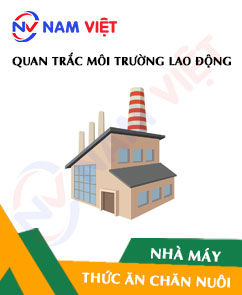
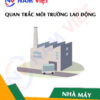
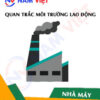
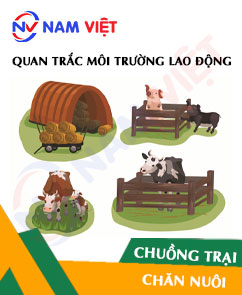
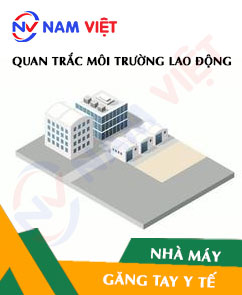

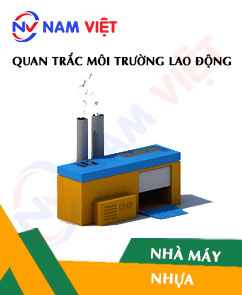



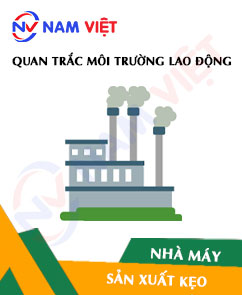
Review Occupational environment monitoring of an animal feed manufacturing factory
There are no reviews yet.